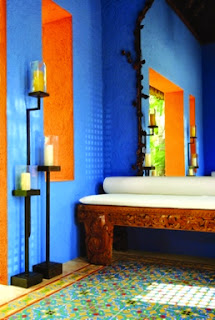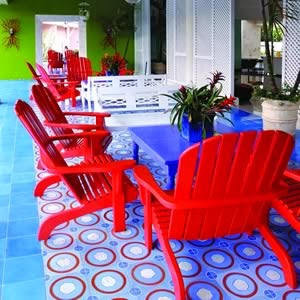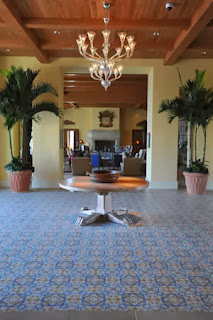 |
| Alcala cement tile in a custom colorway. |
Cement tiles offer flexibility to the architect, designer or homeowner like no other material with its expansive color palette, sustainable properties, timeless patterns and distinct beauty. The stunning Alcala cement tile pattern (pictured above) is a wonderful example of how a custom colorway created an eye-catching floor using warm colors and earth tones.
Cement tiles are often called Cuban tiles because of their ubiquitous use in both residential and commercial applications on the island of Cuba when it was a tropical playground. Cuban tiles patterns are generally more elaborate and often use bold, strong colors.
 |
| The cement tile pattern used here, Cuban Heritage Design 160 2A, runs to the edge of the room (without a border) to create a contemporary feel. |
Did you know that each cement tile is handmade by expert craftsmen who use a process developed over a century ago? Other than slight changes being made to the materials and tools over the years, the manufacturing process remains the same. Handmade cement tiles start as a mixture of natural materials including crushed limestone, Portland cement, aggregate (small stones), sand, and water. Up to 25 artisans handle each tile during the manufacturing process. Some hydraulically press the tile, others rack the tile before it is submerged in a water bath for 24 hours, and a few will layer and pour the mineral pigment in metal molds before it is set out to air-dry for about two weeks. That’s why each and every tile will have its own characteristics.
 |
| The bold palette used on the walls and accent areas is seamlessly repeated in the eye-catching Sosua Cement Tile floor pattern. |
Handmade cement tile floors are the perfect complement to any room. In the example above, the bold palette used on the walls and accent areas is seamlessly repeated in the eye-catching Sosua Cement Tile floor pattern.
Further, the versatility of cement tile as a building material shouldn't be restricted to solely indoor walls applications. You can transfer the same rich and silky feeling of cement tile to the outdoors where you and your guests experience a new environment. However, although cement tile can be used outdoors, it cannot be used in frost-prone environments.
 |
| Dominican artist Cándido Bidó is the creative force behind the bold Espiral cement tile design used on this open-air patio floor. |
Similarly, Moroccan design and its various styling elements have always enjoyed great popularity. The same can also be said of Moroccan cement tile patterns with their playful geometric patterns that work well in both contemporary and traditional environments.
 |
| Fez, the Moroccan cement tile pattern pictured here, offers a playful geometrics that work well in both contemporary and traditional environments. |
It should also be noted that cement tile shouldn't be restricted to residential use. With their inherit qualities of strength and longevity, cement tiles provide a sophisticated and grand entrance for any high-traffic or hospitality type environment.
 |
| San Tropez cement tile pattern, used in this resort's lobby, features a color pallet that includes blue, mustard, white and gray. |
In regards to installation, cement tiles can be installed on wooden sub-floors. For residential flooring applications, it’s recommended you install cement tiles on a backerboard with a 1/2" plywood sub-floor above the floor boards.
As for maintenance, cement tiles should be regularly mopped with clear water. A capful of liquid wax may be added to the water to improve the tiles' natural sheen. Also, never use acids to clean the tiles as they will sustain damage. Avente Tile’s handmade cement tile FAQs will help answer most, if not all, your questions.
Are you ready to start planning your cement tile project? Then make sure to view the dozens of possibilities within Avente’s Cement Tile Design Ideas portfolio pages.



No comments:
Post a Comment